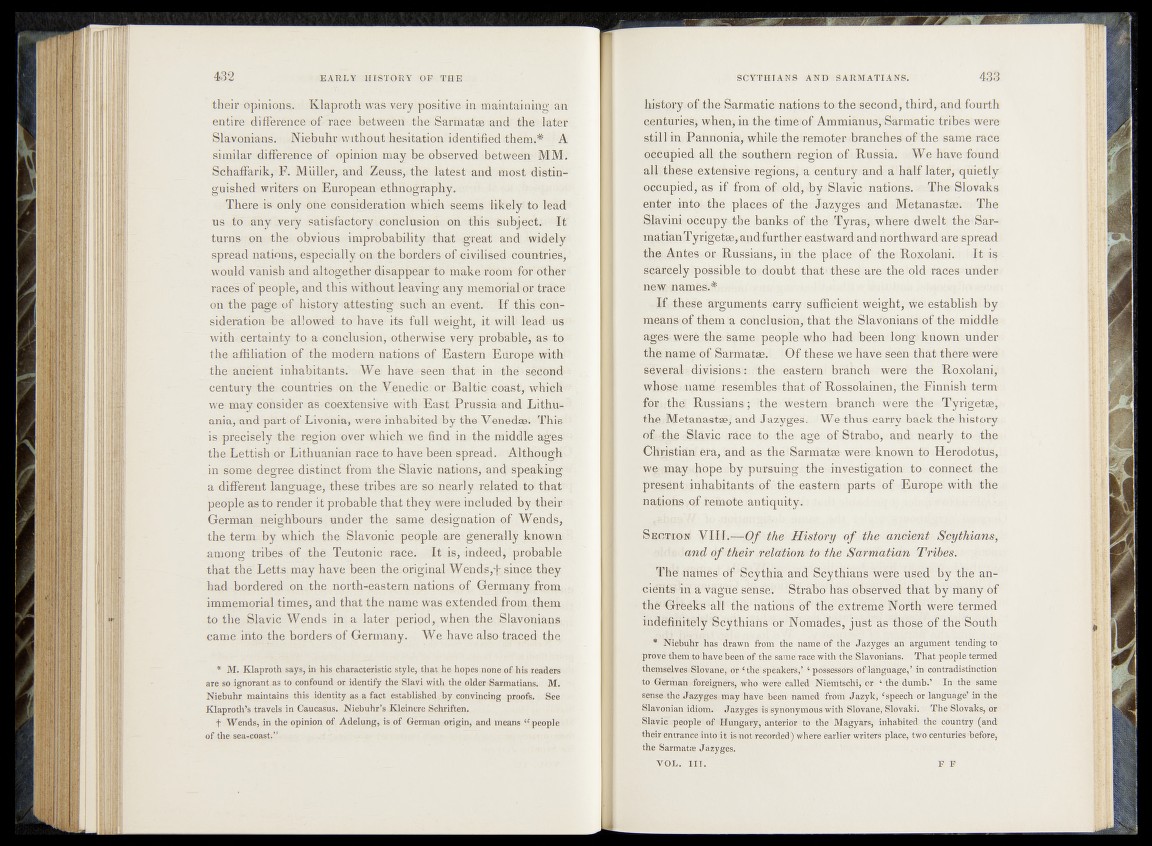
their opinions,., Klaproth was very positive m.maintaitring:an
entire difference of race between the.Sarraatæ and the later
Slavonians. Niebuhr wtthontjfesitaton identified them.* A
similar difference of opinion may be observed between MM.
Schafiarik, F. Müller, and Zeuss, the latest and most distinguished
writers on European ethnography. .
There is only one'consideration which seems likely to lead
us to any very satisfactory.conclusion on this subject. It
turns on the obvious improbability that great and widely
spread nations, especially on the borders of civilised countries,
would vanish and altogether disappear to make room for other
races of people* and this without leaving'any memorial or trace
on the p^fe ofÿhistory attesting such an event.' i f this 'consideration
be allowed to have its full weight, it will» lead us
with certainty to a conclusion, otherwise very probable, as to
the affiliation of the modern nations of Eastern Europe with
the ancient inhabitants. We have- seen ’that im>thé’>second
century thé countries rön the Veuedieror Baltic-coast* which
we may consider as coextensive with East »Prussia and LithU-
ania, and part of Livonia* were inhabited by theVenedmvThis
is precisely the region over which we find in the middle agCjJ^
the Lettish or Lithuanian race to have been spread. Although
in some degree distinct from the Slavic nations, and. speaking
a different language, these tribes are so nearly related to1 that*
people as to render it probable that they were included fey^fbeir
German neighbours under the same designation of Wends,
the term, by which the Slavonic peuple are generally known
among tribes of the Teutonic race. It is, indfeed* probable
that the Letts, may have been the original W e n t h e y
had bordered, on the north-eastern nations of Germany from
immemorial times, and that the name was ^ |;epded <fropi them
to the Slavic Wends in a later period, when the Slavonians
camé into the borders of Germany. We have also traced the
* M. Klaproth says, in his characteristic style, that, he hopes none of his readers
are so ignorant as to confound or identify the Slayi with the older Sarmatians. M.
Niebuhr maintains this identity as a fact established by convincing proofs. See
Klaproth’s travels in Caucasus. Niebuhr’s Kleinere Schrifiten.
f Wends, in the opinion of Adelung, is of German origin, and means “ people
of the sea-coast;”
history of ;the;Snrmati© nati@n®!t 0ithe second, third, and fourth
«^nfcurinsj w-heuf ln A e timêrof Ammianus, Sarmutic tribes were
still in: Pahnoniay while the reimotepiteandiesef the same race
oêpÿtpieA all the: southern région of Russia. We have found
all thesc-ex:tëhsi#eî regions, a century/and a half later; quietly
occupied, as if from o f tsld, -byiSlavic ;nations. -• The Slovaks
enter into^t-he places b f the Jazyges-- and Metanastee; The
^lûvimfjoécupy t ie hanks» aftthe;.?Tÿrahf^hîere dwelt fhe*Sar-
in^tianTyrigete,. and further eafetoard and northward are spread
the Antes or- Russians,- in the place1» of the Roxolafli. ; It is
scarcely possible to doubt th a t' these are the old races under
new/narnfes.^
If these arguments carry sufficiënte weight; We? establish by
mganSi of them a cahclusion, that the/ SlavToniaris:of the middle
ages-were the» same/ people who had been long! known under-
thfe name of Bamiatæ. _ We» have seen that there/were: ;
sfeeral - divisinnskisr!thteaè^sté»ni hranclwo were the Roxolani,
whose, name rïesèhahlesîthat of RosSolainen* the 'Finnish term
fûHf/thet ■ Russians. ; »the weitern; »branch w e re th e ■ T.yrigetæy?.
the iMetana^tasI and Jau g é s* / We thus carry back thé history
o£>frtid »Slavic »raceitd/ithe» age.*of Strabo, and nearly tor these
CffpstiMàfâra, and as/theiSarinatae’were known to Herodotus;;
we imayjihopeiby pursuingfthe-«investigation to conriect the
p r ie n t inhabitants; of the eastern parts of Europe with the
nations n f remote antiquity^ : I
Section! V III.—-Of the History o f the ancient Scythians,
b Sand o f their relation to the Sarmatian Tribes.
Thd names d f * lp y th i r i arid Scythians wèrè used by the an-
ciéritim a Vague sensé1.’ ‘Strabô''has ÖDsrirvëd'tliat by riïany of
thëGfeéks all the liatioris of the ëxtrérhè'North were termed
indëfîftitëlÿ 'Scÿfhianis^of ^ÎVbiriaaris, ‘ j usieas fhÖleeöf ttieBôûth 1
* Niebuhr has drawn from the name of the Jazyges' an argument tending to
prove tBetn to have been of the same race withthéi Slavonians. That people termed
themselvesiSiovane, or ‘the speakers,’ ‘ possessors'of language,’ in-contradistinction
to German' foreigners, who were Called1 NiènltscM;-ibr' ^thfe dumb.’ In the same
sense the Jazyges may have been named frons Jazyk, ‘speech or language* in the
Slavonian idiottn Jazygés ls"SynönymóiAs with Slovàne/ Slovak!. The Slovaks, or
Slavic people of Hungary, aritMor tó th e1 Magyars;* inhabited; the country (and
their entrance into it is-not- recorded) wh ere èarlier writers place, two centuries ‘before,
the Sarmatæ Jazyges.
VOL. III. F F